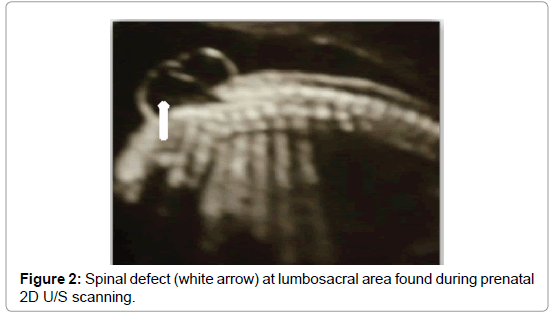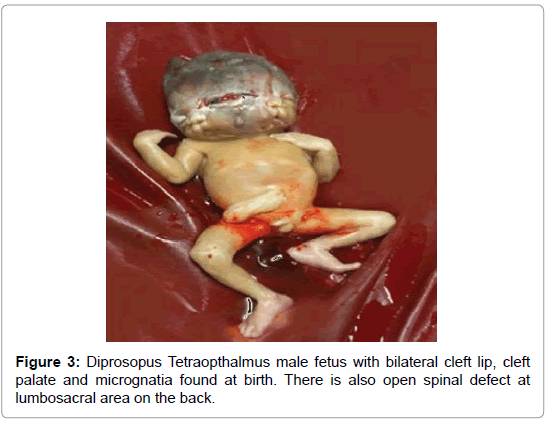Diprosopus Associated with Chiari II Malformation and Bilateral Cleft Lip and Palate: Case Report from Ethiopia and Review of the Literatures
Received: 16-Apr-2018 / Accepted Date: 15-May-2018 / Published Date: 22-May-2018 DOI: 10.4172/2376-127X.1000376
Abstract
Background: Diprosopus is exceedingly rare variant of symmetric conjoined twinning having single neck and body with wide spectrum of duplication of the craniofacial structures. This case is reported to highlight the rarest variant of diprosopus.
Case presentation: A 22 years old gravida two para one mother has undergone termination of pregnancy for prenatally diagnosed Chiari II malformation (CM-II) diagnosed by two dimensional ultrasound (2D US) in JUMC. She expelled a male, mono-cephalic diprosopus abortus, having two faces with mirror image to each other. Each face has two eyes, one mouth, one nose, midline cleft lip and palate, one lateral ear, chins with micrognathia. Additionally it has hydrocephalus and spina bifida.
Conclusion: Presence of abnormal shape of the head and neural tube defects on conventional 2D US should encourage clinician to evaluate with 3D US not to miss other associated craniofacial malformations.
Keywords: Diprosopus; Chiari II malformation; Cleft lip and palate; Conjoined twin; 2D/3D US
Introduction
Diprosopus (Greek, di-, “two” + prosopon, “face” to mean ‘two face’) is exceedingly rare variant of conjoined twinning (0.4%) having single neck and body with wide spectrum of duplication of the craniofacial structures ranging from partial duplication of few facial structures to complete dicephalus [1]. The reported incidence of diprosopus is one in 180,000-15 million births and is more common in females [2].
The pathogenesis of diprosopus is still not well understood. Although many authors classically considered diprosopus as conjoined twinning secondary to the fusion or incomplete separation of two embryos, some has showed that it is the result of abnormal activity by Sonic Hedgehog Homolog (SHH) protein. SHH and its corresponding gene have been found to play an important role in signaling craniofacial patterning during embryonic development. In excess it leads to widening of facial features and duplication of facial structures [3]. Inadequate amounts of this protein lead to opposite conditions such as cyclopia where facial features are insufficiently developed [4].
Case Presentation
A 22 years old gravida two para one mother, at gestational age of 25 weeks was admitted to JUMC gynecology ward for termination of pregnancy for diagnosed congenital anomaly. Her current pregnancy is problematic. She is known RVI patient on anti-retroviral therapy (Lamivudine 300 mg+Efaverenz 600 mg+TDF 300 mg) once daily for the past 15 months. She has undergone cesarean delivery four years back for an indication of mal-presentation and post-term pregnancy.
Obstetric Ultrasound showed singleton intrauterine pregnancy with positive fetal heart beat, fundal placenta, mild polyhydramnios and abnormal head shape with two duplicated intracranial structures fused in the center, but having common enlarged posterior fossa. On the right side lateral ventricles have atrial diameter of 21 mm and 19 mm while on the left atrial diameters measure 24 mm and 28 mm. There was also 3 × 3 cms defect at lumbo-sacral area through which hypo echoic mass protruded. Femoral Length measurement corresponds to gestational age of 25 weeks (Figures 1 and 2).
Following admission, the client was counseled and informed consent taken. She was given 200 mg of Mifepristone orally. After 24 h, four doses of 50 μg misoprostol inserted vaginally every four hours. She has got adequate uterine contraction, cervix fully dilated and cephalocentheasis was done to assist expulsion of male abortus weighing 900 g.
Examination of the fetus at expulsion showed: Mono-cephalic fetus with two faces with mirror image to each other. Each face has two eyes, one mouth, one nose, mid-line cleft lip and palate, one lateral ear, chins with micrognathia. The cranium has two frontal and two sets of parietal bones that were medially hypo-plastic, one occipital bone, two temporal bones, two anterior and one posterior fontanel were observed. It has single neck and single body. There is about 3 × 3 cms open spinal defect at lumbosacral area. Other body parts are grossly normal.The mother was counseled for autopsy, but she refused because she wants intact dead body for burial ceremony (Figure 3).
Discussion
In diprosopus, the facial structures that frequently duplicate are noses and eyes. It often occurs in combination with other congenital disorders. Most frequently associated anomalies are: Anencephaly, neural tube defects, duplication of cerebral hemispheres, cranio-rachischisis, oral clefts, spinal abnormalities, congenital heart defects, diaphragmatic hernia, thoracic and/or abdominal visceral laterality anomalies as mentioned in one recently published systematic review [5].
Cases of diprosopus associated with cleft lip and palate are reported in some literatures [3,4,6,7]. Diprosopus associated with CM-II and anencephaly was observed in different reports [1,6-8]. Our case has partial craniofacial duplication associated with both CM-II and bilateral cleft lip and palate. These similar combinations of anomalies with diprosopus are seen only in one report among 30 published cases of diprosopus accessed by the authors [7]. However, one other case with diprosopus has hydrocephalus, cleft lip and palate, but missing spina bifida [6].
Advances in prenatal imaging and diagnostic tools often allow for recognition of complex, rare and even life threatening congenital malformations prior to birth. Prenatal diagnosis of these conditions provides time for earlier counseling and planning for perinatal management options [8]. Although conventional 2D US is sufficient for prenatal diagnostic purposes, 3D US application is also useful due to its improved soft tissue definition that allows a clear and detailed analysis of facial features and confirming the diagnosis [9,10]. Abnormal shape of the head should pose a warning in conventional 2D US. In addition, choroid plexus, thalamus and cerebellum structures being two pairs provide significant hints during diagnosis [11]. In our case we used 2D US, but we failed to diagnose diprosopus and cleft lip and palate prenatally although we have seen many clues for craniofacial malformations. This can be due to the rarity of the case and no previous experience of such case.
A post-mortem conventional radiograph can be obtained to evaluate any skeletal anomalies like duplication of the cervical spine and upper thoracic spine as it has been witnessed in literatures [6,9]. Cardiovascular anomalies associated with diprosopus are common. Thus it is wise to consider fetal echocardiography after suspecting craniofacial anomalies and neural tube defects as multiple fetal cardiac pathologies like tetralogy of fallot and septal defects are picked with prenatal echocardiographic evaluation of diprosopus cases reported so far [6,8,9]. Detailed assessment of different anatomic anomalies is missed in our case as we haven’t done specialized sonography and autopsy
Conclusion
Whenever conventional 2D US shows abnormal shape of the head and neural tube defects, clinician should take it as opportunity to evaluate with 3D US application so as to look for associated craniofacial malformation and to use all available investigation modalities to see for additional anomalies. This helps clinician to have full prenatal diagnosis and provides time for earlier counseling and planning for perinatal management options and postmortem evaluation.
Acknowledgement
We thank the client for giving us the consent for publication. We also thank those who are involved in the management of this patient.
References
- Vaidya M, Ghike S, Jain S, Joshi S (2014) Diprosopus: A rare conjoined twin. J South Asian Feder Obst Gynae 6: 116-117.
- Suryawanshi P, Deshpande M, Verma N, Mahendrakar V, Mahendrakar S (2013) Craniofacial duplication: A case report. J Clin Diagn Res 7: 2025-2026.
- Hu D, Helms JA (1999) The role of sonic hedgehog in normal and abnormal craniofacial morphogenesis. Development 126: 4873-4884.
- Young DL, Schneider RA, Hu D, Helms JA (2000) Genetic and teratogenic approaches to craniofacial development. Crit Rev Oral Biol Med 11: 304-317.
- Bidondo MP, Groisman B, Tardivo A, Tomasoni F, Tejeiro V, et al. (2016) Diprosopus: Systematic review and report of two cases. Birth Defects Res A Clin Mol Teratol 106: 993-1007.
- Laor T, Stanek J, Leach JL (2012) Diprosopus tetraophthalmus: CT as a complement to autopsy. Br J Radiol 85: e10-13.
- Bulbul Y, Drummond CL, Hillion Y, Bidat L, Ville Y (2004) Diprosopus associated with neural tube defect and facial cleft in the first trimester. Fetal Diagn Ther 19: 246-250.
- Thornton KM, Bennett T, Singh V, Mardis N, Linebarger J, et al. (2014) A case of diprosopus: Perinatal counseling and management. Case Rep Pediatr.
- Fernandes GL, Matsubara FK, Marques FK, Torloni MR, Sancovski M, et al. (2010) Three-dimensional prenatal diagnosis of monocephalus diprosopus tetraophthalmos. J Ultrasound Med 29: 501-503.
- Merz E, Weber G, Bahlmann F, Miric-Tesanic D (1997) Application of transvaginal and transabdominal three dimensional ultrasound for the detection or exclusion of malformations of fetal face. Ultrasound Obstet Gynecol 9: 237-243.
- Kavak SB, Kavak EC, Coskun B, Ilhan R, Orak U (2015) A monocephalus diprosopus fetus: Antenatal sonographic findings. Med Sci 4: 2928-2932.
Citation: Tesemma MG, Sori DA, Hailu DA (2018) Diprosopus Associated with Chiari II Malformation and Bilateral Cleft Lip and Palate: Case Report from Ethiopia and Review of the Literatures. J Preg Child Health 5: 376. DOI: 10.4172/2376-127X.1000376
Copyright: © 2018 Tesemma MG, et al. This is an open-access article distributed under the terms of the Creative Commons Attribution License, which permits unrestricted use, distribution, and reproduction in any medium, provided the original author and source are credited.
Share This Article
Recommended Journals
Open Access Journals
Article Tools
Article Usage
- Total views: 5507
- [From(publication date): 0-2018 - Nov 21, 2024]
- Breakdown by view type
- HTML page views: 4727
- PDF downloads: 780



